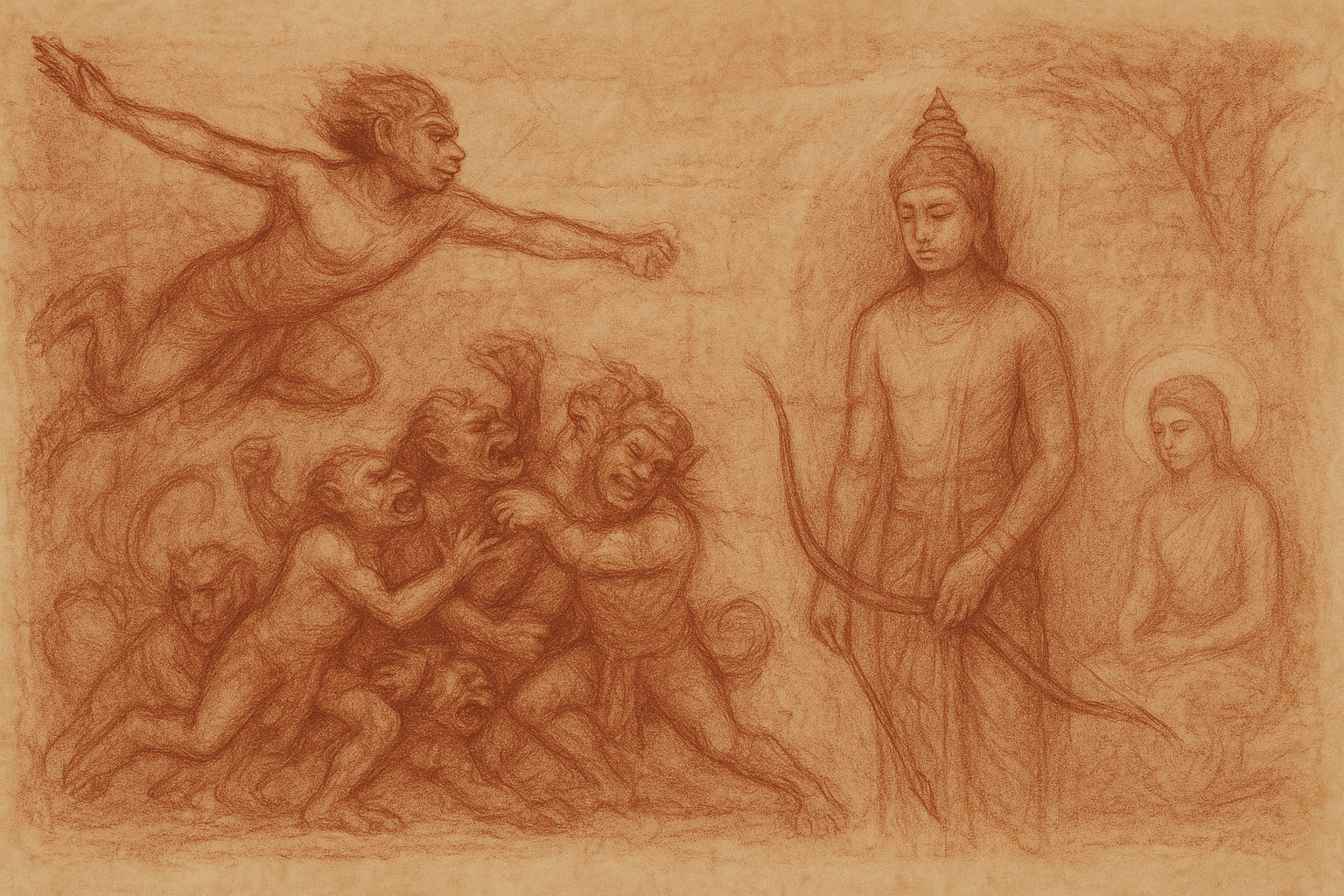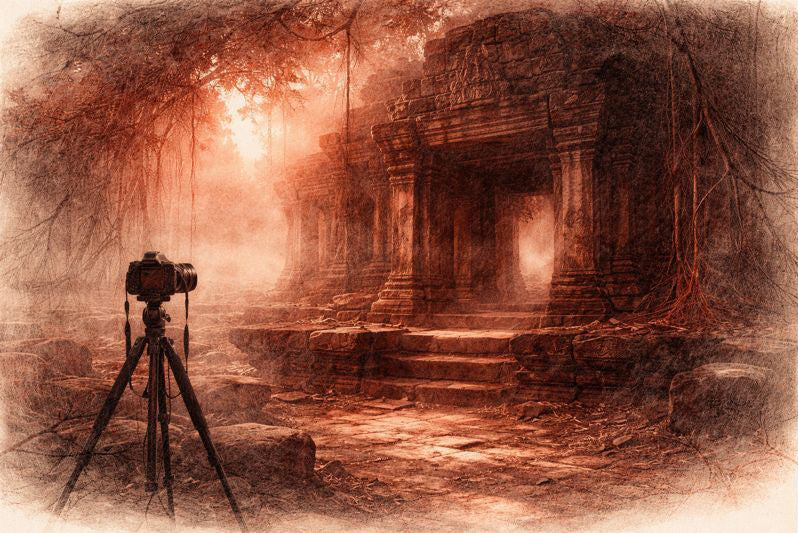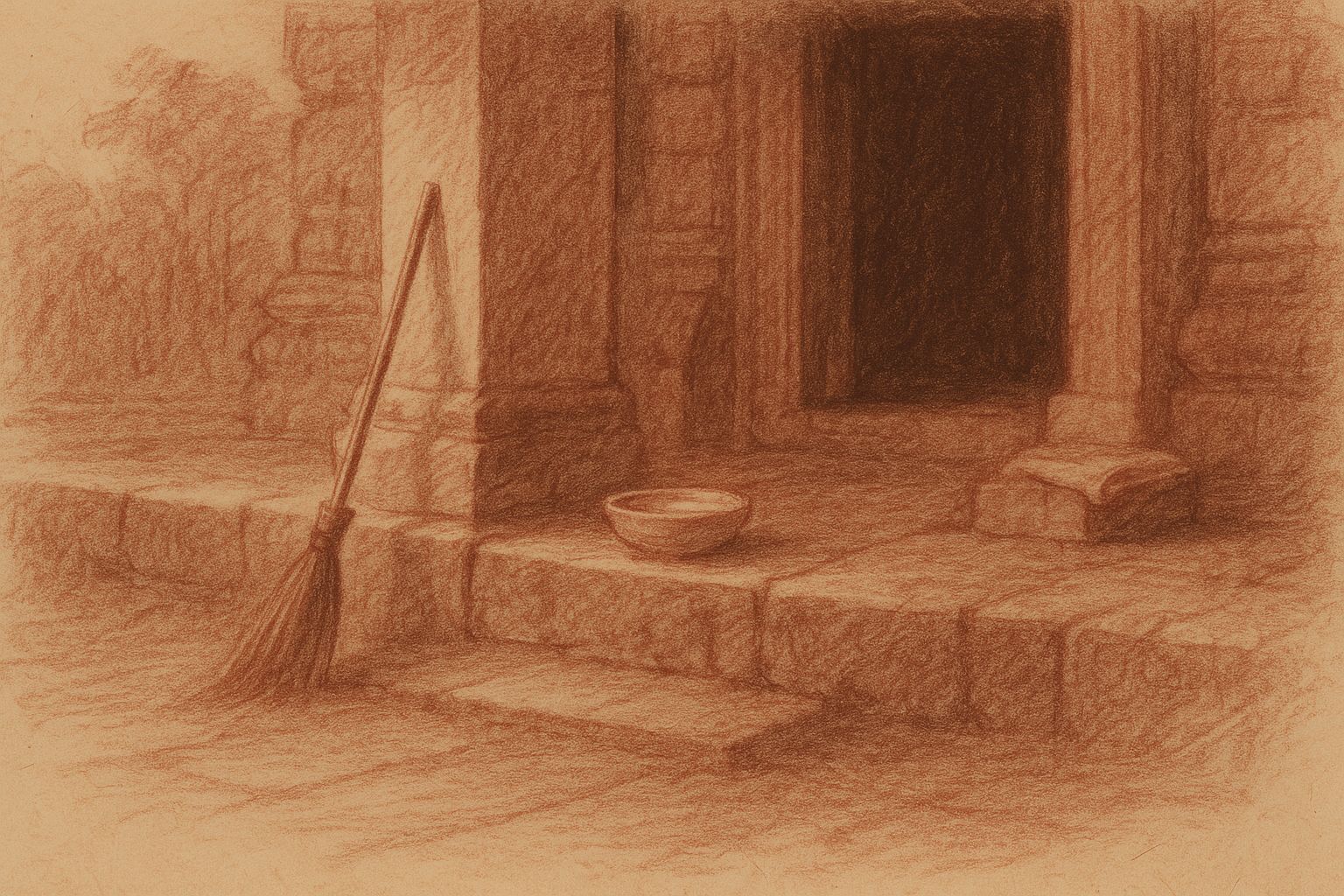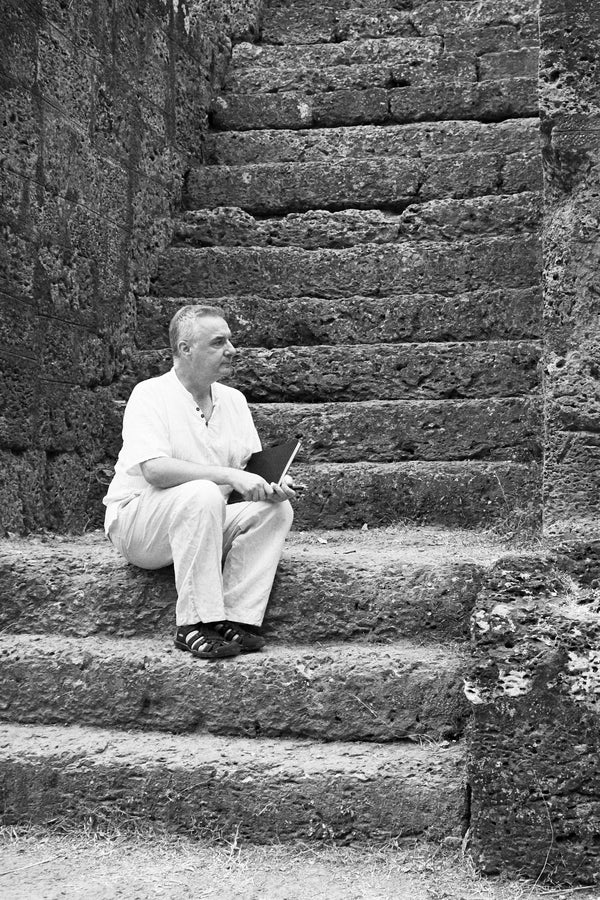Complimentary worldwide shipping on orders over $400 · No import tariffs for most countries
Complimentary worldwide shipping on orders over $400 · No import tariffs for most countries

When the Ramayana Was Carved in Stone
4 min read
Sanctuary of Meaning · Artist’s Journal
He lifted the bow of the ancients,
but in the Khmer telling,
he had to strike a moving bird—
because dharma is never still.
—
There are stories spoken with ceremony, and stories carved in silence. But few are both.
By the seventh century, the Ramayana was already sacred to the Khmer world. Inscriptions such as the stele of Veal Kantel called for its daily recitation—without interruption—alongside the Harivamsha and the Puranas. These were not tales for pleasure, but liturgies of breath. Sanskrit, in this context, was not merely the tongue of kings, but the language of invocation. Its syllables carried power. Its cadence shaped the soul.
To chant the Ramayana was to align with the cosmic pulse. To speak its verses was to echo the architecture of the unseen. Rama was not a distant hero but the luminous pattern of just kingship. Sita was not merely beloved—she was the land itself. The epic did not entertain. It consecrated.
—
By the reign of Jayavarman VII, in the twilight of the twelfth century, the Ramayana had become more than myth. It had become mirror. Like Rama, Jayavarman endured exile. His city was taken, his throne lost to the Chams—who could easily be cast as rakshasas in this sacred unfolding. His return to Angkor, like Rama’s to Ayodhya, marked not a political triumph but a restoration of order, both temporal and divine.
Under his gaze, the Ramayana became a royal mudrā—a gesture of sovereignty shaped in spirit. Through its telling, kingship was no longer domination, but dharma fulfilled. Sita, in this Khmer vision, was Cambodia herself—sacred, violated, and awaiting restoration through virtue, vision, and vow.
—
Over time, the Khmer gave birth to their own telling: the Reamker, or Ramakerti—“the Glory of Rama.” By the seventeenth century, this Cambodian incarnation had taken root, passed from palm-leaf manuscripts to temple murals to the breath of oral tradition. It did not seek to echo the Sanskrit original. It sought to inhabit it—infused with local soil, animist breath, and the devotional cadence of Khmer cosmology.
In the Reamker, familiar scenes are reimagined. Instead of lifting Shiva’s immovable bow, Sita’s svayamvara demands that her suitor strike a bird hidden behind a spinning wheel—a trial of grace and precision. Not brute strength, but stillness in motion. Not conquest, but clarity.
These are not distortions, but variations within the raga of myth. The Reamker softens the blade of heroism into the radiance of compassion. It quiets the warrior’s roar into the whisper of merit. Its glory lies not in domination, but in the flowering of dharma through devotion.
—

Rama & Lakshmana as Young Archers, Baphuon Temple, Angkor, Cambodia
—
Nowhere does this devotional spirit breathe more vividly than in stone.
At Angkor Wat, Banteay Srei, the Baphuon, and beyond, the Ramayana is not read. It is revealed. Panel by panel, the epic unfurls across sandstone like a scripture carved in shadow and flame.
The most fervent scenes arise from the Yuddha Kāṇḍa—the climactic war of Lanka. Hanuman leaps oceans. Monkey warriors vault through air, caught in the rapture of play and purpose. Rama confronts Ravana in a duel drawn across lifetimes. Yet it is not Rama who commands the wall—it is the vanaras, the monkey host, whose wild reverence ignites the frieze.
They are feral and faithful. Tricksters and sages. They bite, tumble, clash, and crouch. They beat drums, wrestle demons, dance in delight. In their ecstatic movement, the Khmer sculptors gave us a vision of bhakti unbound—devotion that protects, disrupts, and overflows.
—
And still, these artisans were not chroniclers. They were spiritual editors.
They carved:
-
Rama’s exile and forest wanderings
-
Encounters with sages, rakshasas, and dreamlike beings of the wood
-
The abduction of Sita beneath the sorrowful acacia
-
Hanuman’s leap, the ring of remembrance, the fire of Lanka
-
Sita’s trial by flame—not to prove chastity, but to unveil divine radiance
And they left uncarved:
-
The Uttara Kāṇḍa—Rama’s second abandonment of Sita, perhaps too fractured for sacred continuity
-
The Ashvamedha Yajna, the horse sacrifice—too imperial, too foreign
-
The fall of Jatayu—the noble vulture whose death is honoured in India, but left silent here
These were not omissions of ignorance. They were choices. Khmer storytellers did not carve what was told. They carved what endured.
—
And in this sacred atmosphere, the tale becomes elemental.
Rama is light—the still flame of kingship, unwavering, pure.
Sita is earth—enduring, wounded, and waiting beneath sky.
Hanuman is wind—a bridge between spirit and matter, mischief and miracle.
They are not characters. They are cosmic functions—moving through stone as through soul.
—
To walk the cruciform galleries of Angkor Wat, or rest a hand upon the rose-swept walls of Banteay Srei, is to enter more than a monument. It is to enter a scripture that breathes. The Ramayana here is not narrated. It is embodied. Each frieze is a gesture. Each shadow, a verse.
The moss remembers the hymns.
The sandstone sings when touched by dawn.
We do not read these stories.
We are read by them.
And in the hush before sunrise, when the jungle softens and the carvings begin to stir, one understands what the ancients knew:
That mythology is not fantasy.
It is the invisible architecture of the soul.
—
Stillness remembers what history forgets.
Also in Library

Before the Shutter Falls
3 min read
Before the shutter falls, fear sharpens and doubt measures the cost of waiting. In the quiet hours before dawn, the act of not-yet-beginning becomes a discipline of attention. This essay reflects on patience, restraint, and the quiet mercy that arrives when outcome loosens its hold.

Those Who Keep the Way Open — On the Quiet Guardians of Angkor’s Thresholds
3 min read
Quiet gestures shape the way into Angkor — a swept stone, a refilled bowl, a hand steadying a guardian lion. This essay reflects on the unseen custodians whose daily care keeps the thresholds open, revealing how sacredness endures not through stone alone, but through those who tend its meaning.

Multiplicity and Mercy — The Face Towers of Jayavarman VII
5 min read
A new vision of kingship rises at the Bayon: serene faces turned to every horizon, shaping a world where authority is expressed as care. Moving through the terraces, one enters a field of steady, compassionate presence — a landscape where stone, light, and time teach through quiet attention.
Devotion, Unbound
Angkor Wat Temple, Angkor, Cambodia — 2020
Limited Edition Archival Pigment Print
Edition
Strictly limited to 25 prints + 2 Artist’s Proofs
Medium
Hand-toned black-and-white archival pigment print on Hahnemühle Bamboo — a museum-grade fine art paper chosen for its quiet tactility and reverent depth, echoing the spirit of the temples.
Signature & Numbering
Each print is individually signed and numbered by the artist on the border (recto)
Certificate of Authenticity
Accompanies every print
Image Size
8 x 8 inches (20.3 x 20.3 cm)
Before the birds herald day, a dusky hush clings to Angkor Wat’s Western Gallery. Within that hush, two figures ignite—a vanara’s jaws closing upon a rakshasa’s thigh, their limbs blazing across the centuries in unwavering purpose. The wall itself seems to inhale, holding the precise moment when loyalty surpasses fear.
This stillness hums with unseen currents: sandalwood breeze, latent thunder, the breath of hundreds of stone warriors who bear silent witness. Yet all sound recedes into the gravity of this single bite, chiselled conviction etched into sandstone and darkness alike.
Lucas Varro knelt for this encounter as one might kneel at a shrine: heart quiet, shutter poised, body stilled to receive what the wall would disclose. Medium-format black-and-white film gathered the lingering night; long exposure let devotion root itself in silver. Later, chiaroscuro shaping and hand-toning coaxed hidden embers to the surface, until violence revealed its secret tenderness.
Strictly limited to twenty-five prints with two Artist’s Proofs, each sheet rests on museum-grade Hahnemühle Bamboo paper whose warm fibers cradle the image like well-worn prayer beads. Signed, numbered, and accompanied by a certificate of authenticity, every impression bears the trace of the artist’s steady hand.
Invite this fierce serenity into the room where your quietest questions wait.
To walk further into the silence behind the stone, click here to enter the Artist’s Journal.
Previously titled ‘Battle of Lanka I, Study I, Angkor Wat Temple, Cambodia. 2020,’ this photograph has been renamed to better reflect its place in the series and its spiritual tone. The edition, provenance, and authenticity remain unchanged.
Join My Studio Journal
Receive occasional letters from my studio in Siem Reap—offering a glimpse into my creative process, early access to new fine art prints, field notes from the temples of Angkor, exhibition announcements, and reflections on beauty, impermanence, and the spirit of place.
No noise. No clutter. Just quiet inspiration, delivered gently.
Subscribe and stay connected to the unfolding story.

Join My Studio Journal
Receive occasional letters from my studio in Siem Reap—offering a glimpse into my creative process, early access to new fine art prints, field notes from the temples of Angkor, exhibition announcements, and reflections on beauty, impermanence, and the spirit of place.
No noise. No clutter. Just quiet inspiration, delivered gently.
Subscribe and stay connected to the unfolding story.

